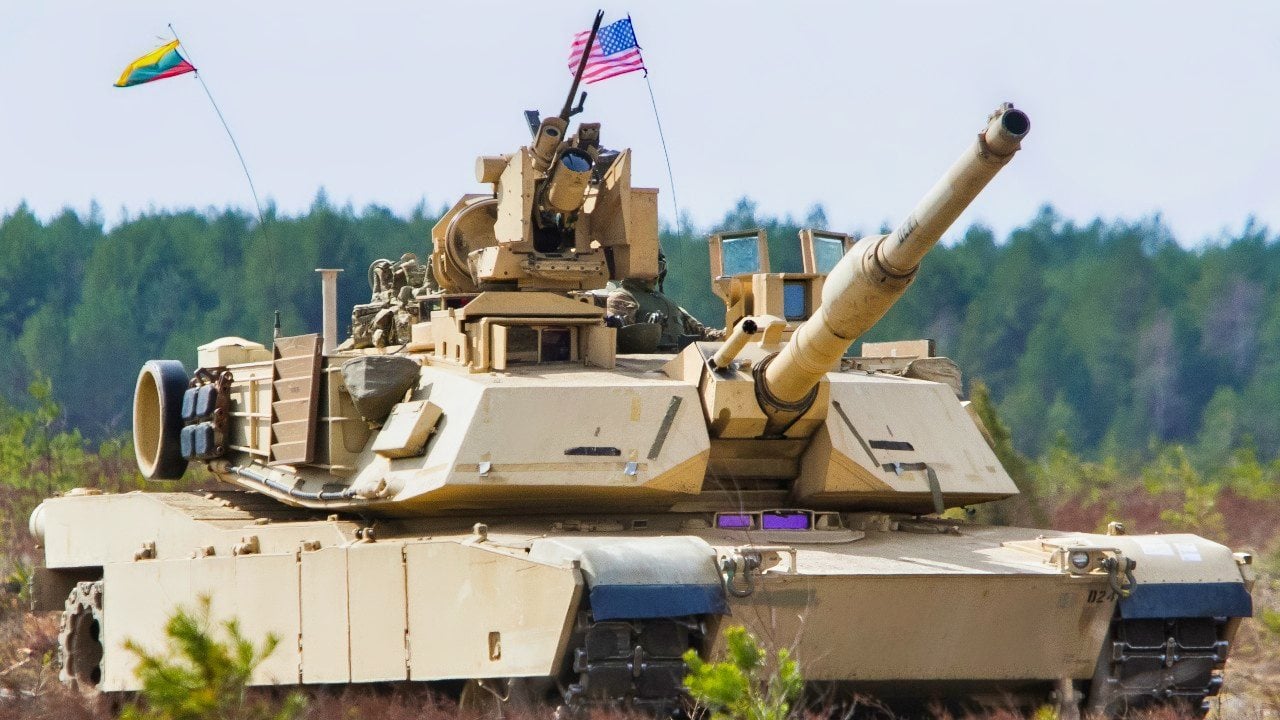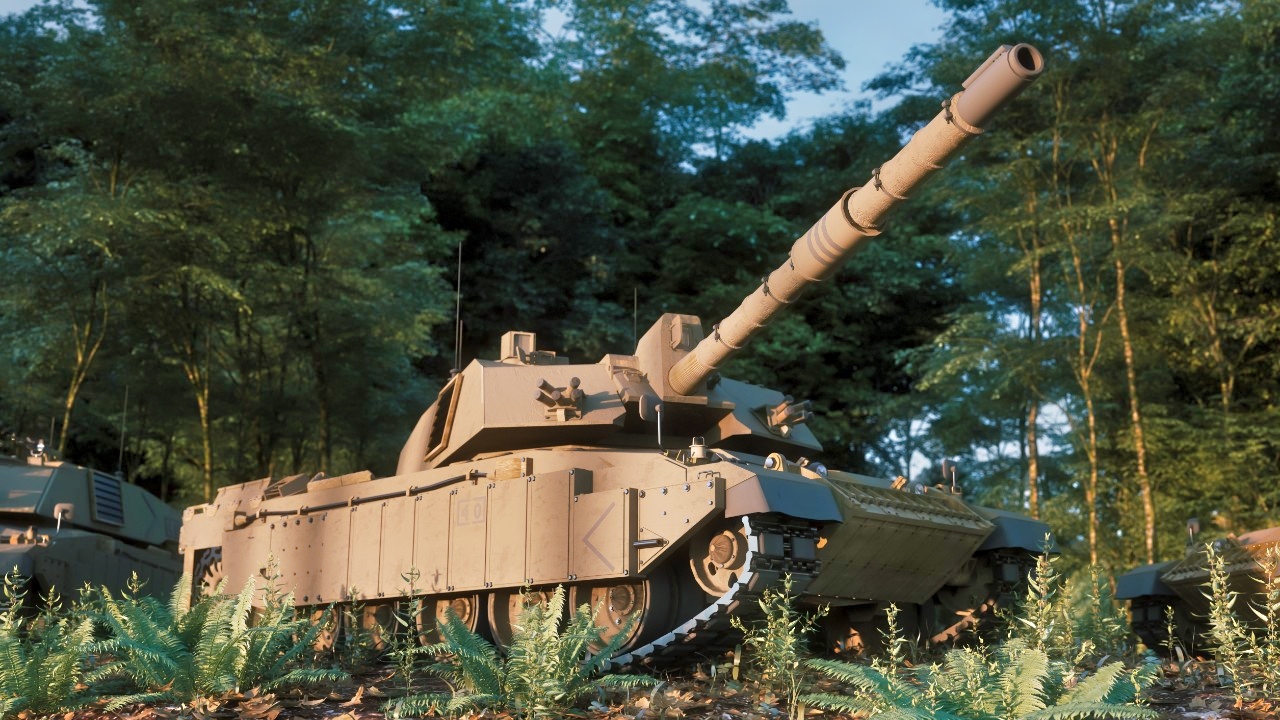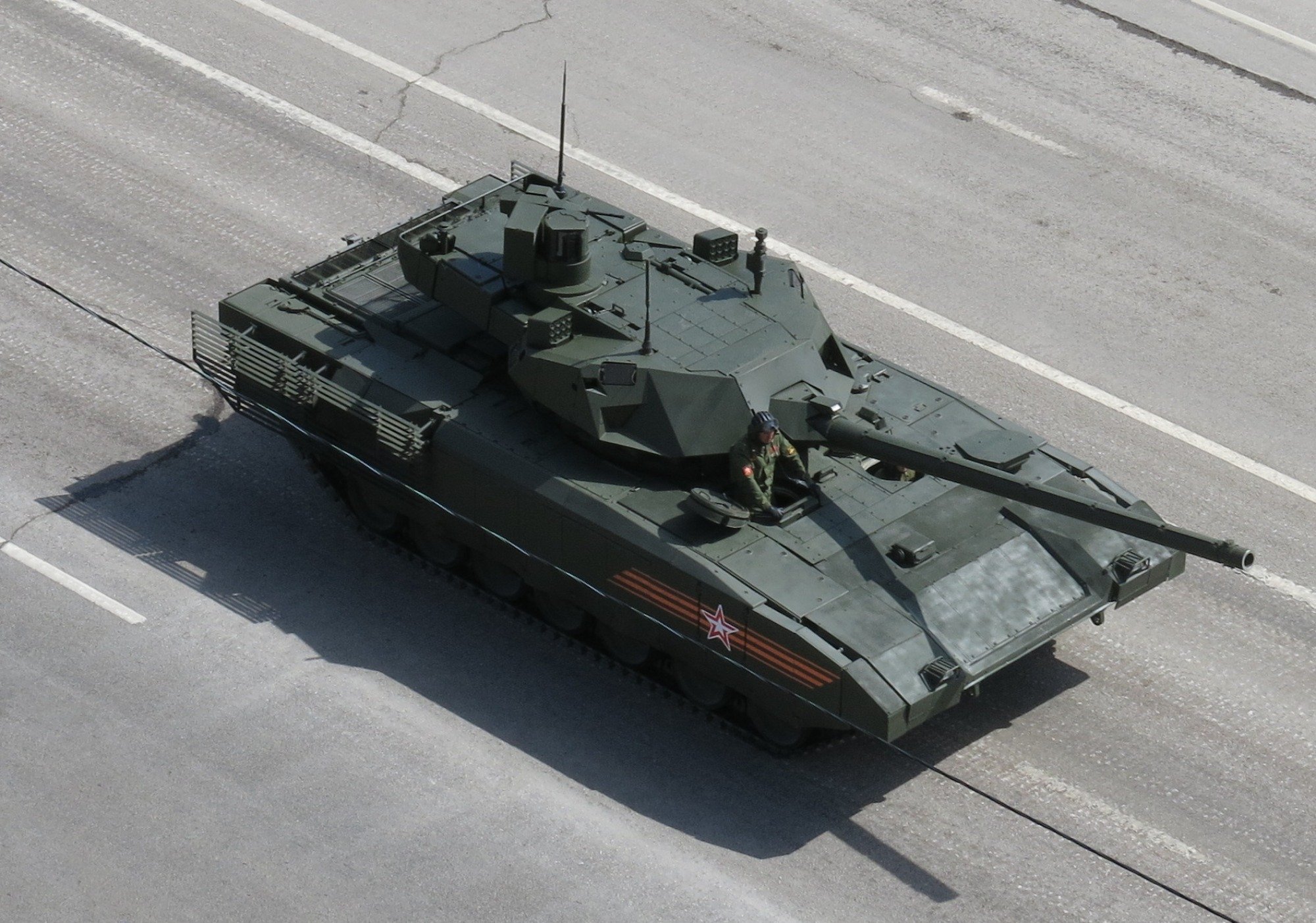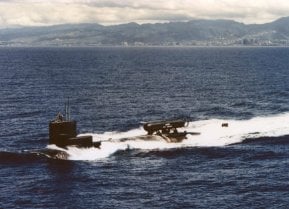10 Best Tanks on the Battlefield Fighting Right Now in 2024
Main Battle Tanks (MBTs) remain pivotal in modern warfare, exemplified by their use in the Russia-Ukraine conflict. While tanks like Russia’s advanced T-14 Armata are technologically superior, their high costs and complexity have led to reliance on older models like the T-72, which offers affordability and ease of mass production.
What You Need to Know: Main Battle Tanks (MBTs) remain pivotal in modern warfare, exemplified by their use in the Russia-Ukraine conflict. While tanks like Russia’s advanced T-14 Armata are technologically superior, their high costs and complexity have led to reliance on older models like the T-72, which offers affordability and ease of mass production.

-Similarly, the U.S. continues to use the aging M1 Abrams, facing challenges from modern threats like drones and anti-tank weapons. Other notable tanks include Britain’s Challenger series, Germany’s Leopard II, China’s T-99, South Korea’s K2 Black Panther, France’s Leclerc XL, and Israel’s Merkava V.
-The effectiveness of MBTs today hinges not only on technological sophistication but also on survivability, affordability, and reliability in diverse combat scenarios.
Top 10 Main Battle Tanks: Which Ones Truly Dominate the Battlefield Today?
The Main Battle Tank (MBT) is a hallmark of modern warfare. Since the final years of the First World War, the land battleship concept has enchanted the minds of ground warfare planners. Armor, speed, mobility, strength, were once all key components in determining which nation had the greatest tanks.
During the Second World War, the Germans were known for the technical prowess and innovation of their engineers. German Wehrmacht tanks were the envy of the world. Yet, they were costly and hard to mass produce. The American tanks, on the other hand, were believed to be lesser tanks than their German rivals.
Yet, the Americans could easily mass-produce these tanks and essentially swarm the enemy battle formations.
Soviet tanks were also known for their advantages (so much so that they were wildly popular as exportable weapons platforms). Elizabeth Owens, writing over at Warrior Maven, assesses the newest metrics for determining the best MBTs in the world now defined by their “artificial intelligence and remote sensing capabilities.”
But suppose these capabilities aren’t all they’re cracked up to be in a modern combat setting?
After all, the Russians possess one of the most advanced MBTs ever designed, the T-14 Armata, and it has essentially been retired from the Ukraine War because they are simply too expensive and too complex to maintain in the crucible of modern combat. Given this, the Russians have been forced to rely upon their less advanced, older, Soviet-era T-72 MBT.
The Americans, too, continue to rely upon their decades-old M1 Abrams MBT that defined America’s lightning victory over Saddam Hussein’s forces in Desert Storm.
So, while sophistication can define the greatness of a modern MBT, perhaps there’s more than just whizbang gizmos that should be the metric for defining greatness. Things like survivability, affordability, reliability, and reproductivity should all be factors in determining a tank’s greatness. We must also keep in mind what the purpose of a tank really is.
Go back to the darkest days of WWI, when the first tanks were developed and deployed. Back then, the battle lines had been static. The offensive war of maneuver initiated by Germany in 1914 had been degraded and replaced by a defensive-oriented trench war. Both sides had tired of the interminability of the conflict. Both sides had effectively frozen the war along those trenches, unable to overcome the other. Both sides sought decisive advantages to breakthrough. And the only way to bust through those lines was with technology.
Hence, the advent of the tank.
From that point on, through every war since, the basic purpose of the tank in attack was to punch through fortified enemy lines with fast-moving heavy armor and weapons as well as to push deep into the enemy’s rear, so as to create an overall tactical opportunity for your side to encircle and break the entrenched enemy’s resistance.
But today, MBTs must contend with a bevy of new threats.
Things like Javelin antitank weapons, aerial drones laden with explosives, sophisticated improvised explosive devices (IED), and other unconventional systems have given defenders significant advantages. And, it seems that the more modern the tank, the more damaging to an attacking force their loss is (as is the case with the Russian T-14 Armata).
The Top 10 Tanks on Planet Earth Right Now
With this in mind, the top 10 best tanks in the world are (from least to greatest):
10. British Challenger 3
The next-generation replacement for the much-ballyhooed Challenger-2 MBT, is really more of an upgrade rather than a total replacement. Although, the new tanks are said to have increased capabilities, thanks largely to their network-enabled computer systems and the new, even more powerful main cannon. In this case, the tank is being built with 120mm High Pressure L55A1 main gun which, according to Rheinmetall, the maker of the Challengers, will shoot the latest kinetic energy anti-tank rounds and programmable multi-purpose ammunition.

The tank is equipped for modern electronic warfare capabilities and has enhanced armor protection for its crew as well as high-tech sensors that allow for long-range target acquisition and tracking for the tank commander. This tank is hugely expensive and is unlikely to be mass produced in the numbers that Britain would need to make this tank truly worth it.
9. British Challenger 2
The British Challenger-2 is one of the most overhyped MBTs imaginable. A third-generation tank, it is in use by the British Army and Oman (although the Brits are retiring this MBT in favor of the aforementioned Challenger-3). Equipped with an L30 120mm tank gun, firing both long rod penetrator and High Explosive Squash Head (HESH) ammunition natures, according to the Rheinmetall website (the builder of the Challenger tanks), this tank was given over to the Ukrainians during the tank craze last year.
Sadly, the Challengers are far too heavy and get bogged down in the soft soil of the Ukrainian battlefield. While these MBTs had successful deployments in both Bosnia and Iraq, the fact of the matter is that they did not go up against a near-peer competitor, such as the Russians. Reports indicate that the Challengers have already suffered at least two casualties (out of 14 units) since they were deployed late last year, largely because they are not mobile in the Ukrainian soft soil. So, this tank is completely overrated.
8. German Leopard II
This tank is one of the most advanced MBTs in the world. It was billed as the tank that would save the flailing Ukrainians in the second year of their thus far three-year campaign against Russian invaders. Yet, these tanks have hardly made the difference we were assured they would make. In fact, images have proliferated across the internet showing the Russians dragging a battle-damaged Leopard back to Moscow to put on display after it was abandoned by its Ukrainian tank crew in battle. These tanks are sophisticated, they are maneuverable, they have efficient engines and even greater firepower.

But, as with all Western technology, there aren’t enough of them available and the system is far too expensive and complex to easily reproduce in a timely fashion. In the areas where these tanks can mass, they can be quite effective. But there will never be enough of these tanks to fight against the incoming hordes of Russian invaders.
7. Russian T-14 Armata
Billed as Russia’s greatest tank, this tank is almost too overrated to waste time writing about. Yes, it is truly next-level.
But it is so advanced that it’s way too expensive and complicated to produce in large numbers. Because of its unique technological nature, the tank was pulled early on from the frontlines of Ukraine out of fear that losing even one of these MBTs would be gravely detrimental to Russia. So, regardless of the high level of technology built into this platform; irrespective of how scared of it Western strategists are, it's a wasting asset for Russia.

6. Chinese T-99
Developed in 2000, this third-generation MBT is a strange knockoff of the old Soviet T-90 and merges ripped-off designs from other Western tanks, mixing them together in the T-99. For example, it possesses the modular add-on explosive reactive armor that made
Germany’s aforementioned Leopard-II MBTs so popular. It has an active laser protection system that helps defend it against incoming missiles, disrupts enemy tank optical gear, and can even be deployed against enemy helicopters.
China has mass produced 1,200 of these tanks over the last 20 years, making it the backbone of its armor force. Although, these tanks are relatively untested in combat. Still, it’s a relatively affordable, easily mass-produced tank that brings with it some helpful features. While the American M1 Abrams is likely a better tank, the fact of the matter is that China’s ability to out-produce equipment means that the Americans will be at a deficit.
5. Korean K2 Black Panther
Peter Suciu has described this MBT as the world’s greatest MBT. It has an excellent engine, incredible defenses, a potent 120mm smoothbore gun that can fire up to 10 to 15 rounds per minute. South Korea created this next-generation MBT to counter what it feared would be an eventual North Korean invasion.
This tank rivals, indeed it surpasses anything the North Koreans have in their arsenal. The Turks prefer this tank to any other.

There’s just one problem: the K2 is wildly expensive. In a long-term war in which South Korean infrastructure is destroyed or seriously damaged, how can one mass-produce this system and maintain it?
Save for that, the electronic warfare capability and overall technical prowess in combat that this tank exhibits should make it the best tank in the world.
But it will be difficult to replace these systems once they are lost in large numbers in a major war, making these systems suspect.
4. French Leclerc XL
This MBT is designed for speed and maneuver. It can travel 50 miles per hour and can blast targets as far as 2.5 miles away. This tank is lighter than many of its third-generation MBT counterparts, such as the M1 Abrams.
Because of its lightness, it is nowhere near as well armored as the other tanks it competes against are. The Leclerc does possess reactive armor, though, just like the Leopard-IIs do.
Only three other nations operate this tank. It has a limited combat record. Although, it was used by the United Arab Emirates (UAE) when that country intervened in the Yemen Civil War, where observers said that the Leclerc performed better than did the Saudi arsenal of American-made M1 Abrams MBTs. The production line ended in 2008 and 50 upgraded versions are currently being made. Again, though, mass producing these tanks will be difficult and they may not fare well against a near-peer rival, such as Russia.
3. Israel’s Merkava V
Nicknamed “Barak,” or “Lightning,” Israel’s Merkava V MBT not only has advanced technology, such as sensors and electronic warfare abilities, but it also has an artificial intelligence system. It has one 120mm smooth-bore gun that has been developed by Israel Military Industries able to fire high-penetration projectiles and guided shells with a firing range of up to 4,000 m.
The second armament consists of a 7.62 mm coaxial machine gun, a 7.62 mm machine gun mounted on the right side of the turret roof, and an internally mounted 60 mm breech-loaded mortar. Its sensors and electronics are incredible and it has an impressive engine. It is currently deployed in a limited fashion with the IDF. Considering that Israel is a small country and is not seeking a wider ground war against a near-peer adversary, the Israelis have both an incredible tank and they likely can produce enough of them to maintain fighting capabilities.
2. American M1 Abrams
A legendary MBT with a marvelous service record, this tank is one of the world’s finest systems. Sadly, it is aging. And the upgraded AbramsX version, while it will be even more sophisticated than its predecessor—including having an onboard AI system, like the Israelis have on their new tank—it is no longer relevant to the battlefield.
The Ukraine War alone has proven how drones are far more effective in warfare than are MBTs.
And these tanks are expensive and hard to reproduce, thanks to America’s utterly broken defense industrial base. What’s more, the Abrams promised to Ukraine (around 30 of them) have not fully deployed and will not make the kind of tactical difference Ukraine expects them to.
1. Russian T-72
The reason that this old Soviet tank is the best in the world is because of the fact that it is used by multiple countries. It is easy to operate and cheap. The Russians have found that their war in Ukraine has not gone well by using either its T-90M MBT or its aforementioned T14 Armata.
The T-72 has kept the Russians in the fight. What’s more, these systems are easy to mass produce and when they’re lost (so many have been lost in combat), it doesn’t really matter, because Russia can simply—quite easily and cheaply—produce many more.
The T-72, despite the drones and other hardships it has endured, is winning the war against Ukraine for Russia. It isn’t being done with any finesse. But it’s getting the job done. That’s why this is the greatest tank in the world today.
Author Experience and Expertise: Brandon J. Weichert
Brandon J. Weichert, a National Interest national security analyst, is a former Congressional staffer and geopolitical analyst who is a contributor at The Washington Times, the Asia Times, and The-Pipeline. He is the author of Winning Space: How America Remains a Superpower, Biohacked: China’s Race to Control Life, and The Shadow War: Iran’s Quest for Supremacy. His next book, A Disaster of Our Own Making: How the West Lost Ukraine, is due October 22 from Encounter Books. Weichert can be followed via Twitter @WeTheBrandon.
All images are Creative Commons or Shutterstock.
From the Vault
Russia Freaked Out: Why the U.S. Navy 'Unretired' the Iowa-Class Battleships
Battleship vs. Battlecruiser: Iowa-Class vs. Russia's Kirov-Class (Who Wins?)


